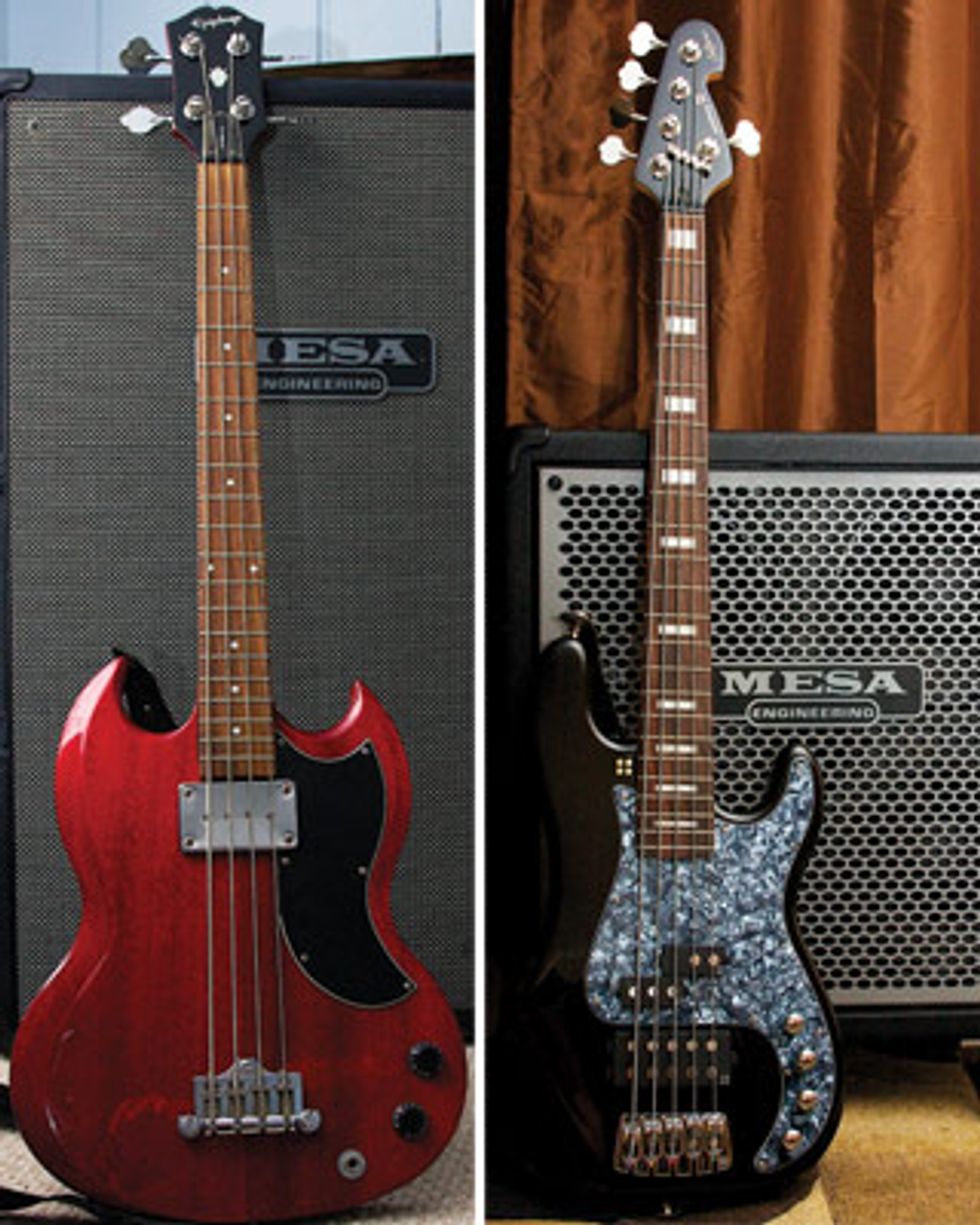What is the sound you hear in your head when you think of the word “bass”?

LEFT: If a gig calls for a large tone with a slower attack that focuses on the sub-low frequencies, the sound from the neck pickup on this short-scale Epiphone and a vintage 6x10 cab should do the trick.
RIGHT: But if the gig needs a punchier, more modern tone, you may want a setup like the Music Man-style pickup from this Sandburg bass, along with a 4x10 cab with extra high-power handling for clean lows.
What is the sound you hear in your head when you think of the word “bass”? For some, it means a huge tone containing the entire frequency range and all the overtones and vibrancy of a grand piano’s low strings. To others, it just means massive low end—like the enormous, pillowy sound that Aston “Family Man” Barrett got with Bob Marley & the Wailers. There are also players who consider bass to be the punchy sound in the low-mid register—that tone many of us affectionately refer to as “the Jaco sound.”
But while the ideal bass sound varies from player to player, in every context there’s a correct sonic space that requires personal tone preferences to be put aside. Fortunately, the setting will dictate the correct space for the bass, as long as you listen and look at what’s going on around you.
When I arrive at rehearsal for a show or a session, I consider a few factors before estimating the space of the bass. I try to estimate the sonic size and placement of my bass tone. My primary focus is always the kick drum, because it’s the only instrument that should be anywhere near me, in terms of frequency. If the drummer is playing a large kick drum with a big, slow, warm attack, I will often go in the opposite direction, sonically picking a more modern sound with plenty of low-mid attack and high-end crispness. I’ll also take out some of the sub-lows to further separate my sound from the drummer.
On the other hand, if the drummer is playing a modern kick drum that’s smaller and tighter, I’ll fatten up my lows, carve out my mids, and make the highs sound slightly mellow. One way to easily achieve this type of tone is by favoring the neck pickup and using a vintage-sounding amp.
The next thing to consider is the guitar situation. Are there two guitarists? Are they using large, closed-back cabs that put out a lot of low end, or are they using smaller, open-back cabs with less bass? Lots of low end from the guitars means you’ll have to create a sub-low frequency, as well as dial in some high, cutting tones. Using a plectrum and playing through a large stage rig with the amp’s lows boosted will help you get heard in this type of situation.
A few years ago, my good friend Jim invited me to check out his show. He plays bass with a 15-piece band that ends up on the top-five list of highest-grossing tours in the U.S. every summer. Jim asked me to give my honest opinion about the mix, and needless to say, I expected it to be top notch. He’s a world-class bassist and was playing a $5,000, custom-made bass with a huge tone that would light up many frequencies on a sonic-spectrum analyzer. It’s the kind of instrument that would make a solo bass piece sound stunning. But, at the end of the night, I had to tell him I had trouble hearing him—even though I saw him play his butt off.
In order to be felt and heard in a band that large, the bass tone can’t be too big. The sound has to be punchy in a very specific register. Since Jim is a professional with 30 years of experience, he had his amp adjusted perfectly onstage—boosting only the critical frequencies and cutting the others to get out of the sonic space belonging to his 14 bandmates. But the front-of-house (FOH) engineer took the bass signal from a DI, which is certainly very common. In this case, it didn’t work to Jim’s advantage and the whole mix suffered. While FOH engineers should be experts at knowing the sonic space for every instrument, sometimes they are not. We can make it easier for them to get the bass tone right in the PA by knowing the space of the bass for that specific band and venue. The decision is as much technical as it is artistic.
A few weeks later, Jim and I went bass shopping. We decided he needed a bass that barked in the mids—to the point of almost sounding “honky.” The bass also needed to have a natural absence of sub-lows. Jim could have purchased any instrument in the store, but we decided on a $700 J-style bass because it had a pronounced bump in a sonic space that would work for his tour.
The FOH engineer ended up being thrilled with the sound of this inexpensive, factory-made instrument. Previously, the engineer had failed to dial in a great tone from the DI because the $5,000 bass gave him too many unusable frequencies. The bump in the mids provided by the budget bass ended up solving that problem before the sound even reached the soundboard!
If you listen to and observe the players and equipment around you, you will have the tools you need to find the right space for the bass. The resulting tone may not be what you love at home or in the store, but it will be the right tone for the gig. And the wisdom and discipline required to make those choices is every bit as important as that cool bass part you’re playing.
 Victor Brodén
Victor BrodénNashville bassist and producer Victor Brodén has toured and recorded with more than 25 major-label artists, including LeAnn Rimes, Richard Marx, Casting Crowns, and Randy Houser. His credits also include Grammy-winning albums and numerous television specials on CMT and GAC, as well as performances on The Tonight Show and The Ellen DeGeneres Show. You can reach him at vbroden@yahoo.com.

